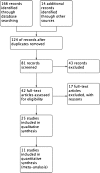What is the prognostic impact of FDG PET in locally advanced head and neck squamous cell carcinoma treated with concomitant chemo-radiotherapy? A systematic review and meta-analysis
- PMID: 29948105
- PMCID: PMC6182396
- DOI: 10.1007/s00259-018-4065-5
What is the prognostic impact of FDG PET in locally advanced head and neck squamous cell carcinoma treated with concomitant chemo-radiotherapy? A systematic review and meta-analysis
Abstract
Purpose: Evidence is conflicting on the prognostic value of 18F-fluorodeoxyglucose (FDG) positron emission tomography (PET) in head and neck squamous cell carcinoma. The aim of our study was to determine the impact of semiquantitative and qualitative metabolic parameters on the outcome in patients managed with standard treatment for locally advanced disease.
Methods: A systematic review of the literature was conducted. A meta-analysis was performed of studies providing estimates of relative risk (RR) for the association between semiquantitative metabolic parameters and efficacy outcome measures.
Results: The analysis included 25 studies, for a total of 2,223 subjects. The most frequent primary tumour site was the oropharynx (1,150/2,223 patients, 51.7%). According to the available data, the majority of patients had stage III/IV disease (1,709/1,799, 94.9%; no information available in four studies) and were treated with standard concurrent chemoradiotherapy (1,562/2,009 patients, 77.7%; only one study without available information). A total of 11, 8 and 4 independent studies provided RR estimates for the association between baseline FDG PET metrics and overall survival (OS), progression-free survival (PFS) and locoregional control (LRC), respectively. High pretreatment metabolic tumour volume (MTV) was significantly associated with a worse OS (summary RR 1.86, 95% CI 1.08-3.21), PFS (summary RR 1.81, 95% CI 1.14-2.89) and LRC (summary RR 3.49, 95% CI 1.65-7.35). Given the large heterogeneity (I2 > 50%) affecting the summary measures, no cumulative threshold for an unfavourable prognosis could be defined. No statistically significant association was found between SUVmax and any of the outcome measures.
Conclusion: FDG PET has prognostic relevance in the context of locally advanced head and neck squamous cell carcinoma. Pretreatment MTV is the only metabolic variable with a significant impact on patient outcome. Because of the heterogeneity and the lack of standardized methodology, no definitive conclusions on optimal cut-off values can be drawn.
Keywords: 18F-Fluorodeoxyglucose (FDG) positron emission tomography; Head and neck cancer; Metabolic tumour volume; Radiotherapy.
Conflict of interest statement
Conflicts of interest
None.
Ethical approval
This article does not describe any studies with human participants performed by any of the authors.
Figures







References
Publication types
MeSH terms
Substances
LinkOut - more resources
Full Text Sources
Other Literature Sources

